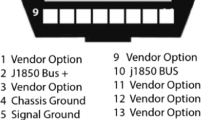Abstract
Behavioral patterns prediction in the context of Vehicular Ad hoc Networks (VANETs) has been receiving increasing attention due to the enabling of on-demand, intelligent traffic analysis and real-time responses to traffic issues. One of these patterns, sequential patterns, is a type of behavioral pattern that describes the occurrence of events in a timely and ordered fashion. In the context of VANETs, these events are defined as an ordered list of road segments traversed by vehicles during their trips from a starting point to their final intended destination. In this paper, a new set of formal definitions depicting vehicular paths as sequential patterns is described. Also, five novel communication schemes have been designed and implemented under a simulated environment to collect vehicular paths; such schemes are classified under two categories: RSU (Road Side Unit)-based and Vehicle-based. After collection, extracted frequent paths are obtained through data mining, and the probability of these frequent paths is measured. In order to evaluate the effectiveness and efficiency of the proposed schemes, extensive experimental analysis has been realized.














Similar content being viewed by others
References
Hartenstein H, Laberteaux KPA (2008) A tutorial survey on vehicular ad hoc networks. IEEE Commun Mag 46(6):164–171
Singh A, Kumar M, Rishi R, Madan DK (2011) A relative study of MANET and VANET: its applications, broadcasting approaches and challenging issues. Commun Comput Inform Sci 132(3):627–632
Boukerche A (2008) Algorithms and protocols for wireless sensor networks. Wiley, New York
Boukerche A (2006) Handbook of algorithms for wireless networking and mobile computing, Chapman and Hall/CRC Computer and Information Science Series
Krumm J, Markov A (2008) Model for driver turn prediction. In: Proceedings of SAE 2008 world congress. Detroit
Lytrivis P, Thomaidis G, Amditis A (2008) Cooperative path prediction in vehicular environments. In: Proceedings of the 11th international IEEE conference on intelligent transportation systems, pp 803-808
Chen M-S, Park JS, Yu PS (1998) Efficient data mining for path traversal patterns. IEEE Trans Knowl Data Eng 10(2):209–221
Simmons R, Browning B, Zhang Y, Sadekar V (2006) Learning to predict driver route and destination intent. In: Proceedings of the 6th IEEE international confernce on intelligent transportation systems, pp 127–132
Andreas DL, Andrea M, Ubbo V, Otthein H (2005) Sequential pattern mining for situation and behavior prediction in simulated robotic soccer. In: Proceedings of the 9th RoboCup international symposium, pp 118-129
Fahad A, Ilias P, Tim M, Vassilis K (2010) Discovery of events with negative behavior against given sequential patterns. In: Proceedings of IEEE conference of intelligent systems, pp 373-378
Jesup E, Casavant KL, Lawson CY (2004) Truck trip data collection methods. Oregon Department of Transportation, Salem
Rawling GF, Reilly PR (1987) CATS commercial vehicle survey of 1986: a discussion of project management issues, CATS Research News. Chicago Area Transportation Study
Ruiter E (1992) Development of an urban truck travel model for the phoenix metropolitan area, final report. Arizona Department of Transportation, Prepared by Cambridge Systematics Inc.
Barton-Aschman Associates Inc (1994) ElPaso Urban Area Travel Study, Commercial Truck Travel Survey, Draft Report, Prepared for the City of ElPaso Metropolitan Planning Organization and the Texas Department of Transportation
Wilbur Smith Associates (1995) Commercial vehicle survey: final report, Prepared for the Houston-Galveston Area Council
The Port Authority of New York and New Jersey (1992) 1991 Inter-state truck commodity survey, vol 2
Barton Aschman Associates, Inc (1991) Truck intercept survey procedures manual. Prepared for Caltrans Alameda County
Gorys J (1991) 1998 Ontario commercial vehicle survey transportation research record no 1313. Transportation Research Board, National Research Council. Washington
Liu T, Bahl P, Chlamtac I (1998) Mobility modeling, location tracking, and trajectory prediction in wireless ATM networks. IEEE J Sel Areas Commun 16(6):922–936
Zaidi ZR, Mark BL (2005) Real-time mobility tracking algorithms for cellular networks based on Kalman filtering. IEEE Trans Mob Comput 4(2):195–208
Rezgui J, Cherkaoui S (2011) Detecting faulty and malicious vehicles using rule-based communications data mining. In: Proceedings of IEEE local computer networks, pp 827–834
Kargl F, Ma Z, Schoch E (2006) Security engineering for VANETs. In: Proceedings of the 4th workshop on embedded security in cars (escar 2006)
Bae I-H, Olariu S (2010) A tolerant context-aware driver assistance system for VANETs-based smart cars. In: Proceedings of IEEE global telecommunications conference (GLOBECOM 2010), pp 1–5
Xue G, Li Z, Zhu H, Liu Y (2009) Traffic-known urban vehicular route prediction based on partial mobility patterns, In: Proceedings of 2009 international conference on parallel and distributed systems (ICPADS 2009), pp 369–375
Froehlich J, Krumm J (2008) Route prediction from trip observations. In: Proceedings of SAE 2008 world congress. Detroit
Samarah S, Al-Hajri M, Boukerche A (2011) Predictive energy-efficient technique to support object-tracking sensor networks. IEEE Trans Veh Technol 60(2):656–663
Agrawal R, Srikant R (1995) Mining sequential patterns. In: Proceedings 11th international conference data engineering. Taipei, pp 314
Merah AF, Samarah S, Boukerche A (2012) Vehicular movement patterns: a prediction-based route discovery technique for VANETs. In: Proceedings of IEEE international conference on communications. Ottawa
Ghafoor KZ, Abu Bakar K, Van Eenennaam E, Khokhar RH, Gonzalez AJ (2011) A fuzzy logic approach to beaconing for vehicular ad hoc networks. Int J Telecommun Syst 52(1):139–149
Author information
Authors and Affiliations
Corresponding author
Additional information
This work is partially supported by NSERC DIVA Strategic Network, Canada Research Chairs Program and NSERC Grants
Rights and permissions
About this article
Cite this article
Merah, A.F., Samarah, S., Boukerche, A. et al. A Sequential Patterns Data Mining Approach Towards Vehicular Route Prediction in VANETs. Mobile Netw Appl 18, 788–802 (2013). https://doi.org/10.1007/s11036-013-0459-6
Published:
Issue Date:
DOI: https://doi.org/10.1007/s11036-013-0459-6




